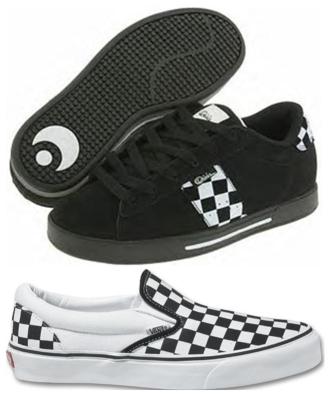Court Denies California Board Sports' Summary Judgment Motion Against Vans
Plaintiff shoe maker California Board Sports, Inc., sued competing shoe maker Vans, Inc., for a declaration of non-infringement and non-dilution relating to Vans’ federal registration for the checkerboard pattern on its “Classic-Slip-On” shoe, or as I called them back in the day, “Spicoli Vans.”
Vans counterclaimed against CBSI for trademark infringement, unfair competition, and misappropriation under California law based on CBSI’s use of a checkerboard pattern on its “Serve Black” shoe.

Likelihood of confusion? Court says maybe
California Board Sports shoe (top) and Vans
CBSI moved for summary judgment on the grounds that Vans’ checkerboard pattern is generic or merely decorative; that the pattern is functional; that there is no likelihood of confusion; and that CBSI’s use of its checkerboard pattern is fair use.
On Nov. 6, the Southern District of California denied UBSI’s motion in its entirety. As to UBSI’s argument that the checkerboard pattern is generic or merely decorative, Judge Irma Gonzalez found that it did not serve the “What are you?” function that a generic mark serves. Instead, the court found that “a black and white checkerboard, while lacking in independent distinctiveness, falls into the class of designs eligible to acquire secondary meaning as a source-identifier.”
The court found that Vans had met its burden. Vans’ “evidence came in the form of a survey in which 45% of respondents — male purchasers of casual and athletic shoes who had purchased such shoes in the past three months or were likely to purchase such shoes in the next three months — misidentified a competitor’s slip-on shoe that copied the checkerboard pattern as a model coming from Defendant.” Even though UBSI objected as to the relevance of a study involving a shoe manufactured by a third party, the court found the study was relevant to the issue of whether consumers generally identify the checkerboard pattern with Vans.
As to functionality, the court found that while it was a close call, a genuine issue of material fact existed as to whether protection of the checkerboard pattern as a trademark would impose a “significant non-reputation related competitive disadvantage.” The court found that while the checkerboard is widely used in fashion generally, “Plaintiff has not connected the protection of the checkerboard pattern with competitive consequences by, for example, introducing evidence that consumers have an affinity for the checkerboard pattern unrelated to Defendant’s use of the pattern on its shoes.” Thus, the court concluded, the checkerboard pattern “acts as a source identifier” for Vans.
UBSI only made half-hearted arguments on likelihood of confusion. The court found: “Extended analysis on this issue is unnecessary. Even discounting the survey data as irrelevant for purposes of determining likelihood of confusion between Plaintiff’s and Defendant’s products, Plaintiff’s concession that many of the above factors favor Defendant suggests that a genuine issue of fact exists on the issue.”
Finally, as to fair use, UBSI essentially argued that because it did not choose its checkerboard pattern to deceive the public, its use is fair use. The court rejected the argument, finding “the principle of fair use and its protection of images in their primary descriptive sense has no relevance to the present controversy.”
The case cite is California Board Sports, Inc. v. Vans, Inc., No. 06-2365, 2007 WL 3276289 (S.D. Calif.).
Reader Comments